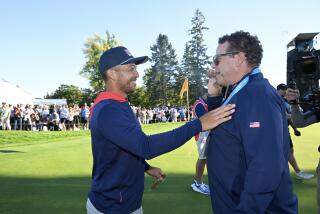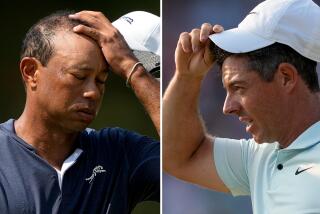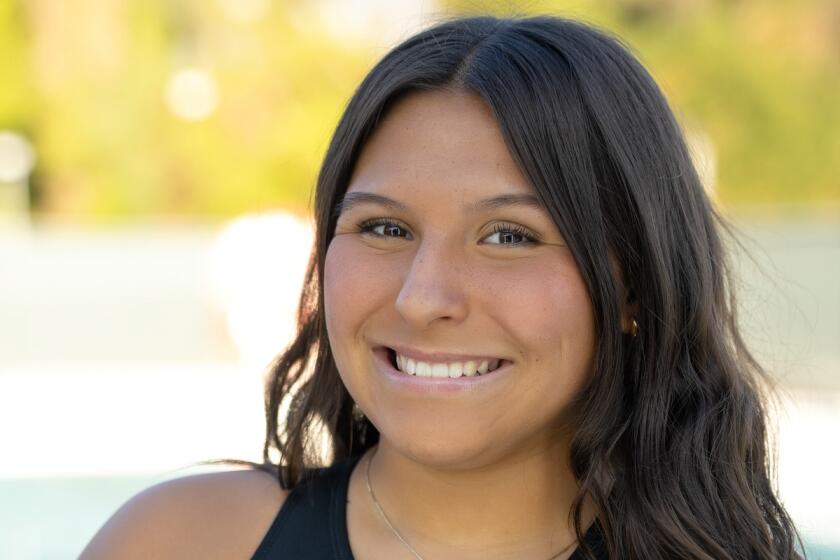Langer Must Wait, See
- Share via
Three weeks away, the Ryder Cup is only going to become bigger and more confusing as we move closer to the showdown between the U.S. and Europe at Oakland Hills Country Club in suburban Detroit.
We already know who’s on the 12-player U.S. team, led by Tiger Woods and Phil Mickelson, but European team captain Bernhard Langer isn’t going to know for sure about his own side until Monday, the day after the BMW International at Munich, Germany, when he makes his two captain’s picks.
So far, Padraig Harrington, Sergio Garcia, Miguel Angel Jimenez, Darren Clarke, Lee Westwood and Thomas Levet are in. Speculation is that Langer will choose Luke Donald and Colin Montgomerie if they fail to qualify on points, and Montgomerie is sure to fall short.
Meanwhile, U.S. captain Hal Sutton has been dropping not-so-subtle hints that he’s going to sit some of his players on the bench. In other words, not everyone is going to play every day. Sutton calls that the opposite of the “politically correct” position, which he blames in part for the U.S. losing six of the last nine Ryder Cup matches.
In the meantime, this is a good opportunity to look at the Ryder Cup and clear up any questions about what’s going on and what’s going to happen:
Question: What’s the deal about Oakland Hills Country Club?
Answer: Designed by Donald Ross and redone by Robert Trent Jones, it has been the site of six U.S. Opens and two PGA Championships.
Willard Mullin of the New York World Telegram nicknamed the course “the Monster.”
At the 1951 U.S. Open, Ben Hogan won with a 67 on the last day and said afterward, “It is the hardest course I’ve ever played. I’m glad I brought this course, this monster, to its knees.”
Q: When was the last U.S. Open played at Oakland Hills?
A: In 1996. Steve Jones won. Jones is one of Sutton’s assistants.
Q: Anything unusual about the place?
A: Start with there being only two par-five holes, the 519-yard second and the 560-yard 12th. It’s 7,077 yards long and plays to par of 70. It has long par-fours, undulating greens that are tiered, uneven fairways and plentiful rough, if it’s set up that way.
Q: Who is the most important person on the Ryder Cup scene right now?
A: It has to be Kerry Haigh, senior director of tournaments for the PGA of America, and the person responsible for setting up the course. Expect softer fairways to cut down on roll (U.S. players play longer than the Europeans and hit the ball farther), high rough (U.S. players are more accustomed to it) and fast greens (ditto).
Q: What is Sutton’s message to his team?
A: Keep the ball below the hole on the undulating, tiered greens. With fast greens, you don’t want too many quick, downhill putts.
Q: How much money is at stake?
A: Experts predict a $240-million impact for the region. With 59 corporate entertainment tents long sold out, the PGA of America is in line for a potential net of $60 million. Each U.S. player receives $80,000 to donate to the charity of his choice.
Q: How many people will be there?
A: Ticket sales are 38,000 a day and officials say that breaks down to 70% corporate packages and 30% general public.
Q: Who will play the most important role on the golf course?
A: That’s the toughest question of all, but does anyone remember Paul McGinley? The 37-year-old from Dublin made a 10-foot putt at the 18th hole to halve his match with Jim Furyk, giving the winning point to the Europeans in their 15 1/2 -12 1/2 romp over the U.S. at the Belfry in 2002. The U.S. needs strong performances from its stars, Woods, Mickelson and Davis Love III.
Q: How well have the U.S. stars played?
A: Not very. Woods is 5-8-2 and Love is 8-9-4. Mickelson, though, is 8-5-3 and one of only two players on the U.S. team with a winning Ryder Cup record. David Toms is 3-1-1.
Q: So, who’s going to win?
A: All signs point to the U.S., playing on its hand-picked and uniquely tailored golf course with two of the top three players in the world and spurred on by their recent failures. Of course, the U.S. is routinely favored and routinely loses, so the only safe prediction is that it’s going to be close.
Q: If he wins, will Sutton toast the golf media for its support, as Langer did for sake of tradition after Europe’s victory at the Belfry?
A: No, but if he loses, expect Sutton to roast the golf media, for sake of tradition.
More to Read
Go beyond the scoreboard
Get the latest on L.A.'s teams in the daily Sports Report newsletter.
You may occasionally receive promotional content from the Los Angeles Times.










